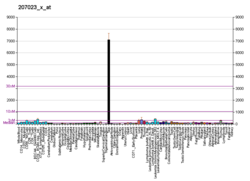
Keratin 1 is a Type II intermediate filament (IFs) of the intracytoplasmatic cytoskeleton. Is co-expressed with and binds to Keratin 10, a Type I keratin, to form a coiled coil heterotypic keratin chain. Keratin 1 and Keratin 10 are specifically expressed in the spinous and granular layers of the epidermis. In contrast, basal layer keratinocytes express little to no Keratin 1. Mutations in KRT1, the gene encoding Keratin 1, have been associated with variants of the disease bullous congenital ichthyosiform erythroderma in which the palms and soles of the feet are affected. Mutations in KRT10 have also been associated with bullous congenital ichthyosiform erythroderma; however, in patients with KRT10 mutations the palms and soles are spared. This difference is likely due to Keratin 9, rather than Keratin 10, being the major binding partner of Keratin 1 in acral keratinocytes.

Keratin, type I cytoskeletal 4 also known as cytokeratin-4 (CK-4) or keratin-4 (K4) is a protein that in humans is encoded by the KRT4 gene.

Keratin 2A also known as keratin 2E or keratin 2 is a protein that in humans is encoded by the KRT2A gene.
Type II keratins constitutes the Type II intermediate filaments (IFs) of the intracytoplasmatic cytoskeleton, which is present in all mammalian epithelial cells. The type 2 cytokeratins consist of basic or neutral, high molecular weight proteins which in vivo are arranged in pairs of heterotypic Type I and Type II keratin chains, coexpressed during differentiation of simple and stratified epithelial tissues. It has been seen that Type II Keratins are developed before Type 1 keratins during human embryonic development.

Keratin 14 is a member of the type I keratin family of intermediate filament proteins. Keratin 14 was the first type I keratin sequence determined. Keratin 14 is also known as cytokeratin-14 (CK-14) or keratin-14 (KRT14). In humans it is encoded by the KRT14 gene.

Keratin 9 is a protein that in humans is encoded by the KRT9 gene.

Keratin 18 is a type I cytokeratin. It is, together with its filament partner keratin 8, perhaps the most commonly found products of the intermediate filament gene family. They are expressed in single layer epithelial tissues of the body. Mutations in this gene have been linked to cryptogenic cirrhosis. Two transcript variants encoding the same protein have been found for this gene.

Keratin, type I cytoskeletal 17 is a protein that in humans is encoded by the KRT17 gene.

Keratin 16 is a protein that in humans is encoded by the KRT16 gene.

Keratin, type II cytoskeletal 8 also known as cytokeratin-8 (CK-8) or keratin-8 (K8) is a keratin protein that is encoded in humans by the KRT8 gene. It is often paired with keratin 18.

Collagen XVII, previously called BP180, is a transmembrane protein which plays a critical role in maintaining the linkage between the intracellular and the extracellular structural elements involved in epidermal adhesion, identified by Diaz and colleagues in 1990.

Laminin subunit beta-3 is a protein that in humans is encoded by the LAMB3 gene.

Loricrin is a protein that in humans is encoded by the LOR gene.

Keratin, type II cuticular Hb1 is a protein that in humans is encoded by the KRT81 gene.

Keratin, type II cuticular Hb6 is a protein that in humans is encoded by the KRT86 gene.

Keratin, type II cytoskeletal 78 is a protein that in humans is encoded by the KRT78 gene.

Keratin, type I cuticular Ha2 is a protein that in humans is encoded by the KRT32 gene.

Keratin, type I cuticular Ha4 is a protein that in humans is encoded by the KRT34 gene.

Keratin, type II cuticular Hb5 is a protein that in humans is encoded by the KRT85 gene.

Keratin, type I cuticular Ha6 is a protein that in humans is encoded by the KRT36 gene.










